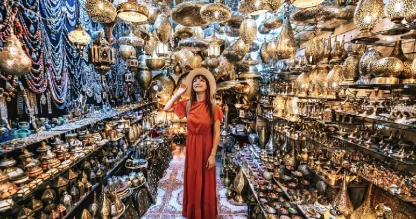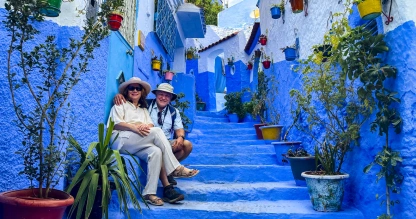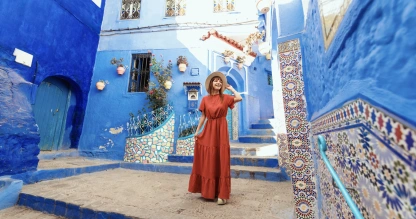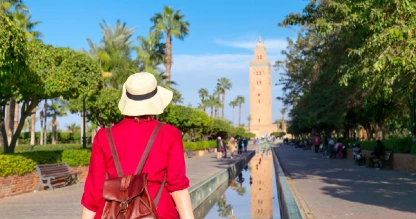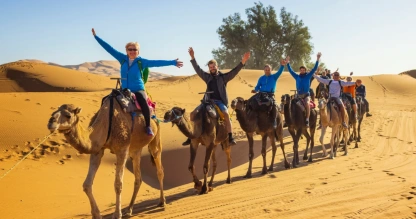
Chefchaouen: Morocco`s iconic blue city
Chefchaouen fascinates visitors with its enchanting blue-washed buildings nestled in Morocco's northern mountains. The picturesque city, founded in 1471 by Moulay Ali Ben Rachid, evolved from a defensive outpost against Portuguese invaders into one of the country's most photographed destinations. The city's relaxed atmosphere provides a stark contrast to Fes and Marrakech's bustling streets, and many travelers describe it as "a breath of fresh air".
The city's unique blend of Andalusian and Berber heritage offers more than just Instagram-worthy blue alleyways. This piece will help you find why Chefchaouen deserves an extended stay on your Morocco tour, whether you explore its winding blue streets or hike to scenic viewpoints.
Why Chefchaouen is More Than Just a Pretty City
The azure alleys of Chefchaouen tell stories that go nowhere near their Instagram appeal. This mountain gem packs cultural and historical value that makes it much more meaningful than its photogenic reputation suggests.
Theories behind the blue walls
The iconic blue hues that cover Chefchaouen's buildings come from several fascinating origins. Jewish tradition says the color blue (tekhelet) represents divinity and heaven - a constant reminder of God's presence. Many sources link this tradition to Jewish refugees who settled here in the 1930s while escaping Hitler's persecution.
A more practical explanation suggests the blue paint keeps mosquitoes away by mimicking flowing water. On top of that, locals say the blue shades help keep homes cooler in warmer months. Some residents believe the blue stands for happiness and optimism in Islamic culture.
Cultural blend of Andalusian and Berber heritage
Chefchaouen's unique identity comes from the natural mixing of Andalusian refugees and indigenous Berber populations. This cultural blend shows up in daily life everywhere. Spanish words mix with local Berber dialects, and Andalusian cooking techniques combine with mountain ingredients.
The city's architecture shows clear Andalusian touches, with curved brick archways that make houses stronger and add beauty to the narrow blue alleyways. Artistic traditions stay alive through Andalusian music, which has become central to Chefchaouen's religious festivals and social ceremonies.

How it compares to Fez and Marrakech
The larger, busier medinas of Fez and Marrakech make Chefchaouen feel more intimate. The medina here might be smaller but it's full of charm. Travelers find Chefchaouen substantially more affordable than Fes, so you can either save money or enjoy luxury for less. Streets are less crowded, which creates a relaxed vibe for exploring and shopping without the pushy haggling you'll find in bigger cities.
Why it's a peaceful start to your Morocco tour
Chefchaouen gives you the perfect introduction to Morocco with its walkable streets and calm atmosphere. You can explore the whole city on foot, so there's no stress about complex transportation systems. Beautiful mountain views and blue-washed streets create a peaceful setting where solo travelers feel right at home. Visitors often feel more comfortable here than in other Moroccan destinations, which makes it ideal to ease into the country's culture at your own pace.

Top Things to Do in Chefchaouen
You need more than a camera to find Chefchaouen's many treasures. This beautiful city blends cultural experiences with natural wonders through its many activities.
Wander the blue alleyways
The narrow streets of Chefchaouen tell stories beyond popular Instagram spots. Local families have kept their traditions alive here for generations. You'll get your best photos away from tourist paths in quieter corners. Streets remain empty before 9am with perfect soft lighting for photography. The city's blue colors change throughout the day - from soft periwinkle at sunrise to rich indigo as night falls.

Visit the Kasbah and Uta el-Hammam Square
A grand 15th-century Kasbah towers over the shaded, cobbled Plaza Uta el-Hammam. This clay-brown fortress stands at the city's heart with its beautiful Andalusian garden. Inside, you'll find a former prison that once held the leader of the 1920s Riffian revolt and a small ethnographic museum. The museum shows local clothing, musical instruments, and historical photographs. A large tree in the square's middle serves as everyone's meeting spot.

Hike to the Spanish Mosque for sunset
The Spanish Protectorate built this hilltop mosque in the 1920s but never finished it due to local resistance. Now it's the city's best viewpoint. The path starts at Plaza Uta el-Hammam through Bab el-Ain gate. This moderate hike takes 45-60 minutes. You should arrive an hour before sunset to catch golden light on blue buildings below, perfect for a Morocco travel package experience.

Explore Ras el-Maa and local fountains
Ras el-Maa waterfall sits just past the medina's northeastern gate. Mountain water tumbles over stone ledges at this natural spot. Local women gather at this "Head of Water" spring to wash clothes. The peaceful sound of water and green surroundings create a calm break from the busy medina.

Try a traditional hammam experience
Local hammams like Hammam Rahma let you experience centuries-old bathing rituals. The process includes steaming, washing, black soap scrubs, and argan oil massages. Bring swimsuit bottoms, sandals, towel, and a smile.
Shop for local crafts and textiles
Local artisans create unique handicrafts from wool ponchos to handwoven rugs, leather goods, and Berber jewelry. The chichia hats stand out - wide-brimmed woven pieces with colorful pom-poms that Rif Mountain women traditionally wear. Shopkeepers welcome you with mint tea and friendly chats. Bargaining happens with smiles here, making shopping fun even if you just browse.

How to Get to the Blue City of Morocco
Chefchaouen, a mountainous blue haven, sits nestled in Morocco's Rif Mountains. The city lacks direct rail connections and an airport, so careful planning becomes essential.
From Tangier: the fastest route
The journey to Chefchaouen takes about 2–3 hours by road. CTM offers reliable bus services with tickets around USD 7–9, while grand taxis charge roughly USD 60–80 per vehicle.
From Fez: scenic but longer
A scenic 4-hour drive links Fez to Chefchaouen through stunning landscapes. CTM runs 5–6 daily buses costing USD 9–15, and private transfers range from USD 100–170, depending on your negotiation.
From Marrakech or Casablanca: what to expect
Longer distances demand more patience. Casablanca offers a direct 6.5-hour CTM bus that departs at 1:45 PM daily. Another option combines the high-speed train to Tangier with onward transportation. Marrakech travelers should prepare for a 10-12 hour bus trip with transfers.
Guided Tours
Many travelers also choose the convenience of guided tours, which often include direct transfers to Chefchaouen from major cities like Tangier, Fes, or Casablanca. These tours save time, remove the hassle of arranging multiple connections, and usually combine transportation with sightseeing stops along the way—making the journey to the Blue City part of the adventure.
Where to Stay and What to Expect
Chefchaouen's iconic blue streets house everything from traditional riads to wallet-friendly hostels.
Best riads in the medina
The old town features some amazing places to stay. Dar Dadicilef stands out with its beautiful gardens and rooftop views. Riad abi khancha gets praise from guests for its comfy beds and great service. These quality riads show amazing hospitality.
Budget vs luxury options
Chefchaouen caters to every type of traveler. Budget visitors can stay in simple hostels and guesthouses for around 80–150 MAD (USD 8–15) per night, often offering cozy rooms and local charm. For those seeking a more upscale experience, luxury riads and boutique stays provide amenities such as indoor pools, panoramic rooftop views, and traditional hammam treatments, with prices starting around USD 200 per night.

What to pack for the terrain and weather
You'll need good walking shoes to handle Chefchaouen's steep and narrow cobblestone streets. The weather stays around 68°F (20°C) throughout the year, but summer days heat up to 86°F (30°C). The temperature drops by a lot during winter evenings, so pack some warm layers.
Prayer times and cultural etiquette
Daily life in Morocco follows Islamic traditions with five prayer times: Fajr at dawn, Dhuhr at midday, Asr in the afternoon, Maghrib at sunset, and Isha at night. Visitors should show respect by wearing clothes that cover their shoulders and knees. On top of that, it's good to accept mint tea when offered - this shows you appreciate local customs.
Chefchaouen is a magical spot in Morocco that gives visitors a unique mix of peaceful beauty and real cultural immersion. This blue gem sits in the Rif Mountains and draws travelers with its picture-perfect blue streets. The city's charm comes from its blend of Andalusian and Berber influences that shape every part of daily life.
The Blue Pearl gives travelers an easier start to Morocco than the busy streets of Fes and Marrakech. You can walk everywhere easily here. The relaxed vibe and welcoming locals let visitors get used to Moroccan life at their own speed. The memories of Chefchaouen stay with you long after you leave.
Ready to discover Morocco's magic? Explore our Morocco Travel Packages and enjoy the best of Middle East trips!
FAQS
Q1. Why is Chefchaouen blue?
The blue paint is said to have been introduced by Jewish refugees in the 15th century, symbolizing the sky and spirituality. Others believe it helps repel mosquitoes and keep homes cool, but today it mainly serves as the city’s unique and charming identity.
Q2. Where is Chefchaouen in Morocco?
Chefchaouen is located in northern Morocco, nestled in the scenic Rif Mountains, about 2–3 hours from Tangier and 4 hours from Fes.
Q3. What to eat in Chefchaouen?
Try Moroccan staples like tagine, couscous, and freshly baked bread. Chefchaouen is also known for its goat cheese, a local specialty.
Q4. Where to stay in Chefchaouen?
Options range from budget-friendly hostels to charming mid-range riads and luxury boutique hotels with hammams and rooftop views.
Q5. How many days are enough in Chefchaouen?
Two days are usually enough to explore the medina, enjoy the blue streets, and take a short hike to nearby viewpoints. Longer stays are perfect for a relaxed pace.


